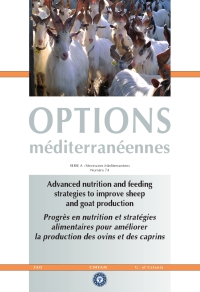| Article précédent | p. 273-278 | Article suivant |
Evaluation of sheep grazing as a tool to restore mountain pastures invaded by Euphorbia polygalifolia
Two experiments were conducted to (i) study whether sheep grazing pastures infested by a spurge (Euphorbia polygalifolia) consume this invasive weed and its consequences on animal performance, and (ii) detect differences between sheep and cattle in ruminal degradation of infested pastures. In the first trial, sheep grazed fenced paddocks highly invaded by spurge at instantaneous stocking rates of 120 ewes/ha/week. Spurge offtake, sward height and ewes' body weight were measured weekly from mid-June to September. An average of 63% of the initial spurge growing points was defoliated per week. Sward height showed a negative curvilinear relationship with the proportion of spurge defoliated, with high spurge defoliation occurring when sward height was lower than 4 cm. Variation in body weight was mainly related to sward height (r = 0.86; P<0.10) and apparent signs of intoxication were never observed. In the second experiment, 6 cows and 8 ewes were distributed according to a factorial design: 2 species (cattle vs sheep) × 2 grazing areas (infested vs non-infested pastures). After seventeen days, rumen fluids were used to study ruminal fermentation of invaded and noninvaded pastures using the in vitro gas production technique. Gas production was always higher in sheep than in cows when the invaded substrate was incubated (P<0.05). The highest values were found in sheep grazing infested pastures and the lowest in cattle maintained in non-infested pastures. This suggests not only a better ruminal degradation of E. polygalifolia by sheep but also a likely adaptation to its consumption.
Deux expériences ont été réalisées (i) pour étudier si l'ovin au pâturage sur pâtures infestées par Euphorbia polygalifolia consomme cette mauvaise herbe envahissante et les conséquences sur les performances animales, et (ii) pour détecter des différences entre les ovins et les bovins dans la dégradation ruminale de ces pâturages infestés. Dans la première expérience, les ovins ont été sur des prés clôturés fortement envahis par E. polygalifolia aux taux instantanés de 120 brebis/ha/semaine. L'utilisation de E. polygalifolia, la hauteur de l'herbe et le poids des ovins ont été mesurés une fois par semaine à partir de la mijuin jusqu'en septembre. Une moyenne de 63% des points initiaux de croissance d'Euphorbia a été défeuillée par semaine. La hauteur de l'herbe a montré un rapport curviligne négatif avec la proportion de E. polygalifolia défeuillée, avec un maximum de défoliation quand la hauteur de l'herbe était inférieure à 4 cm. La variation du poids corporel a été principalement liée à la hauteur de l'herbe (r = 0,86 ; P<0,10) et on n'a jamais observé de signes apparents d'intoxication. Dans la deuxième expérience, 6 vaches et 8 brebis ont été distribuées selon un modèle factoriel : 2 espèces (bovins vs ovins) × 2 zones de pâturage (pâtures infestées vs non infestées). Après dix-sept jours, des fluides de rumen ont été employés pour étudier la fermentation ruminale des pâturages envahis et non envahis en utilisant la technique in vitro de production de gaz. La production de gaz était toujours plus haute chez les ovins que chez les bovins quand le substrat envahi était incubé (P<0,05). Les valeurs les plus élevées ont été trouvées chez les brebis sur pâturages infestés et le plus bas dans les vaches sur pâturages non infestés. Ceci suggère non seulement une meilleure dégradation ruminale de E. polygalifolia par les ovins mais également une adaptation probable à sa consommation.
- [ Afficher ]
- [ Télécharger ]
- [ Exporter la citation ]
Vous pouvez télécharger la citation au format :
- [ Imprimer ]
-
Mots-clés
BREBIS, CONSOMMATION ALIMENTAIRE, EUPHORBIA, EXPERIENCE, MAUVAISE HERBE, PATURAGE, PERFORMANCE ANIMALECiter cet article
Mora M.J., Busqué J., Hervás G., Mantecón A.R., Fernández B., Frutos P. Evaluation of sheep grazing as a tool to restore mountain pastures invaded by Euphorbia polygalifolia. In : Priolo A. (ed.), Biondi L. (ed.), Ben Salem H. (ed.), Morand-Fehr P. (ed.). Advanced nutrition and feeding strategies to improve sheep and goat . Zaragoza : CIHEAM, 2007. p. 273-278. (Options Méditerranéennes : Série A. Séminaires Méditerranéens; n. 74). 11. Seminar of the FAO-CIHEAM Sub-Network on Sheep and Goat Nutrition, 2005/09/08-10, Catania (Italy). http://om.ciheam.org/om/pdf/a74/00800391.pdf



